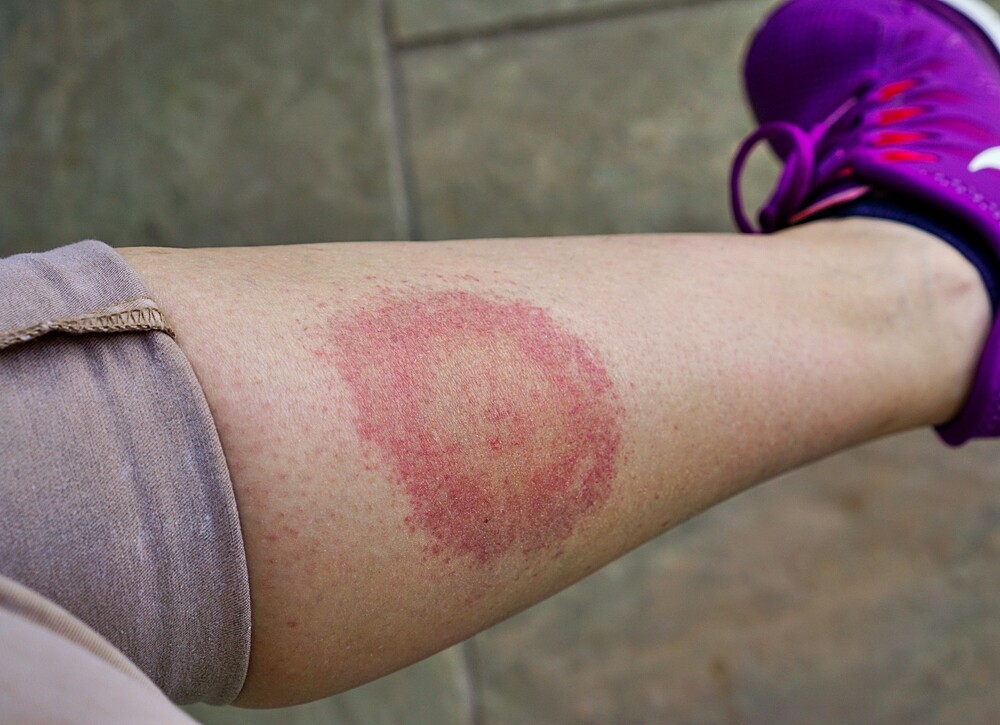The Lyme disease symptoms vary according to the phase of the disease. Here you can find out which signs you should pay attention to and what else you should know.
Lyme disease symptoms: The most important facts in brief
In theory, an infection with Lyme disease is divided into three different disease stages, in each of which different Lyme disease symptoms can occur. However, some experts judge these phases as too rigid: They rather speak of so-called early manifestations (e.g. wandering redness) and late manifestations (e.g. joint inflammation), as the disease does not progress in the same way in all patients. In general, the symptoms of Lyme disease can be quite unspecific and therefore difficult to recognise.
Lyme disease from ticks: How does one fall ill?
The so-called Borrelia pathogens can be transmitted by a tick bite (learn here how to detect a tick bite and remove a tick!) They gradually spread via the blood over the whole body – this is also the reason why the Lyme disease symptoms appear only gradually and get worse with time.
The most common symptoms in the first stage
In about 89 percent of all cases, after a tick bite and infection with Lyme disease, the so-called migratory redness (erythema chronicum migrans or erythema migrans) develops within days to weeks. It usually spreads in a ring around the bite – but in some patients it can be atypical (e.g. it does not migrate or is irregularly spotted). In addition, the following rather unspecific complaints can occur in Lyme disease:
- Tiredness
- Headaches
- Muscle and joint pain
- Loss of appetite
- Fever
- Chills
- Swollen lymph nodes
Lyme disease or summer flu?
As ticks tend to appear in the warm season, the Lyme disease symptoms are often initially mistaken for summer flu. Therefore, the skin around the bite should be closely observed after a tick bite and checked to see if the wandering redness appears.
Lyme disease symptoms in the second stage
It can take months before the Borrelia bacteria reach the organs or attack the nervous system. The following symptoms can occur in this so-called neuroborreliosis:
- Symptoms of paralysis
- Nerve pain
- Sensory disturbances or loss of sensation in certain areas of the skin
If the brain is also affected by the nerves, borreliosis can lead to meningitis. This affects children in particular frequently. In rare cases Borrelia bacteria can also attack the heart and cause an inflammation of the heart muscle or pericardium. Some affected persons also suffer from Lyme disease symptoms on the skin: small red-blue nodules can develop, especially on the earlobes, nipples and scrotum.
Lyme disease symptoms in stage three
It can take months to years from the infection before the third stage of Lyme disease symptoms become noticeable. The following symptoms occur:
- Joint inflammation (Lyme arthritis): This is a chronic or intermittent inflammation of the joints, which occurs due to Lyme disease and is often accompanied by swelling and pain. The inflammation can affect one joint after another.
- Skin inflammation: Inflammation of the skin occurs rather rarely, but if it does, it mainly affects older women. The skin discolours dark red and swells with inflammation, especially on the arms, legs, fingers and toes. As the disease progresses, the affected areas become very sensitive and thin.
- Chronic inflammation of the brain and spinal cord due to Lyme disease: The inflammations also occur only rarely, but can then cause paralysis, coordination and gait disorders as well as speech and hearing disorders.
- Epilepsy: Epilepsy is also rather rare. It triggers symptoms such as impaired consciousness and concentration as well as hallucinations.
Detect Lyme disease and treat it quickly!
In general: The earlier Lyme disease is diagnosed and the earlier the therapy is started, the sooner severe secondary diseases can be prevented.


